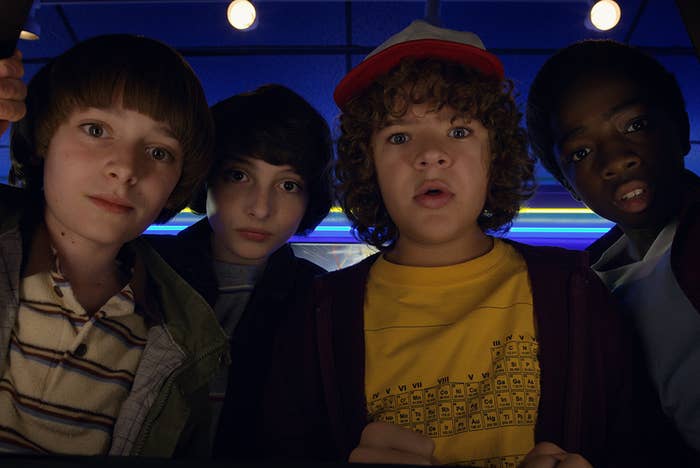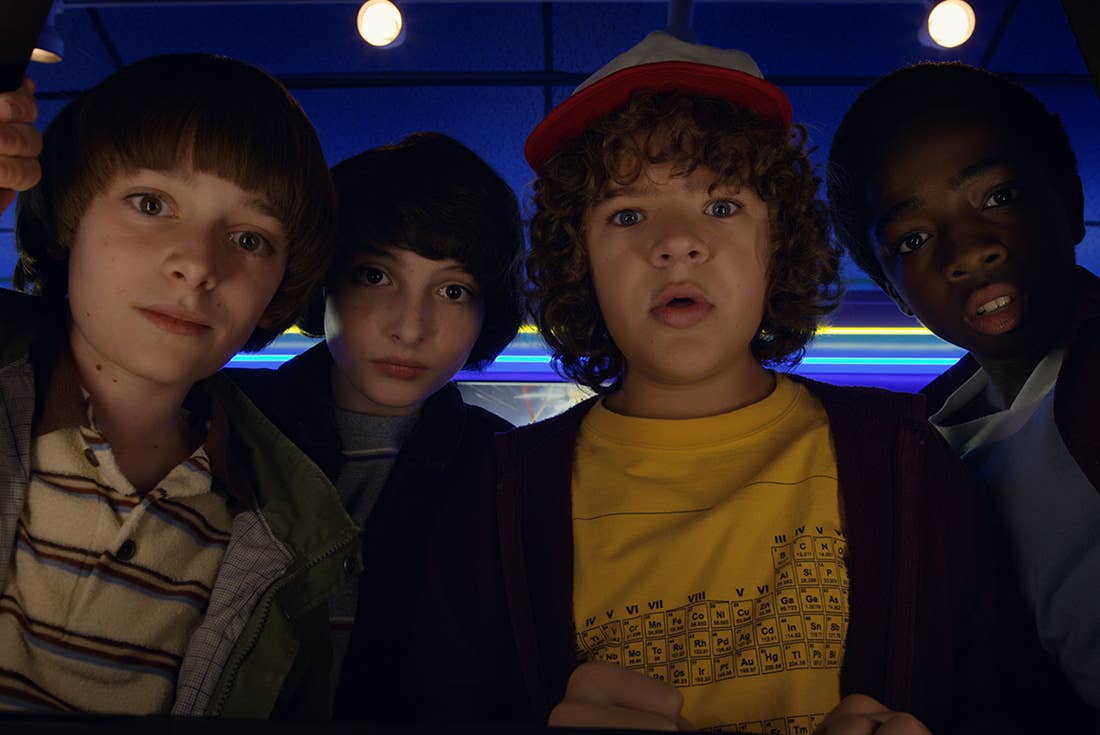
Stranger Things is a loving, fantastically unsubtle homage to classic horror and a nostalgic return to 1983, a time when kids rode their bikes alone at night and the best films had synth-laden soundtracks. Stephen King is arguably the strongest influence in the series, from the title sequence based directly on his book covers to the narratives popularized in their film adaptations, especially Firestarter and Stand by Me. Writers/Directors the Duffer Brothers, Matt and Ross, obviously watched a lot of Stephen Spielberg—that bike chase scene is straight out of E.T. There are also nods to John Carpenter, especially The Thing, Tobe Hooper’s Poltergeist, and the entire Alien franchise.
Season one of Stranger Things was basically a checklist of visual references to horror classics, and the upcoming season looks to continue the trend. Just take a look at those promotional posters based on classics like A Nightmare on Elm Street and The Evil Dead. In advance of tomorrow’s premiere, here are a few of the most prominent references in Stranger Things you need to know.
Firestarter (1984)
View this video on YouTube
Based on the novel by Stephen King, Firestarter tells the story of Charlie, a young girl with pyrokinesis powers that is hunted by a secret government agency. This premise represents the inspiration for Stranger Things’ character Eleven. Like Charlie’s parents, Eleven’s mother was a participant in an experimental governmental program. Here, she was administered psychedelic drugs which led to her child being born with extraordinary powers. The monstrous Dr. Brenner kept the child for his own experiments, with the obvious intent of turning her into a weapon. The connection between Eleven and Charlie is exemplified in a scene where Eleven crushes a can with her mind as a demonstration of her power, which replicates the same scene in Firestarter where Charlie shows off her pyrokinesis to the scientists testing her. Both girls are also monitored with receptors tracking their brain activity, emphasizing their status as science projects, objects and not people.
Additional References: Eleven’s telekinetic powers are similar to those of older female characters, like in Carrie, The Fury, and Phenomena.
Close Encounters of the Third Kind (1977)
View this video on YouTube
There is a particularly strong link between the Duffer Brothers’ Netflix series and Spielberg’s Close Encounters of the Third Kind. When three-year-old Barry is abducted from his home by aliens, his single mother Jillian ignores all warnings to go after him. Like Jillian, Joyce is guided by a primal maternal instinct that’s driven by faith rather than logic. Stranger Things also draws from the use of flashing lights and sounds used to communicate with the aliens in Close Encounters. Will communicates to his mother through flickering the lights in their house, a common ghost movie trope. However, Joyce strings up Christmas lights on the wall to form a large-scale Ouija board to properly converse with her son. Will’s presence is also indicated through sound: Joyce gets calls from him but cannot hear his voice, they can sometimes hear him through their walkie-talkies and his favorite song The Clash’s “Should I Stay or Should I Go” appears frequently.
Additional References: The mother responsible for saving her child appears frequently in horror films, like The Exorcist, The Others, and The Ring.
Alien (1979) & Aliens (1986)
View this video on YouTube
The characters that venture into The Upside Down in Stranger Things echo scenes of exploring the dangerous realms of outer space in Alien. Wearing protective suits and shining torches through the darkness, Joyce and Hopper search through this strange, unnatural place. Named by the boys as the Demogorgon, the monster from their game of Dungeons & Dragons, the creature in Stranger Things is inspired by H.R. Giger’s designs for Alien, an elongated human-like form with stretched limbs and long claws. It also wraps its victims in cobweb-like cocoons, and when Will is found his mouth is covered with a tiny face-hugger directly from these films. In the finale, Hopper even discovers a glowing egg that bodes further danger.
Additional References: The monster draws from lots of references, like Predator, The Thing, and even Little Shop Of Horrors.
A Nightmare On Elm Street (1984)
View this video on YouTube
The character of Nancy in Stranger Things is named after the archetypal Final Girl from A Nightmare On Elm Street, Nancy Thompson. When she sees that torn-up image of Barb by the pool and the creature lurking in the shadows, she is determined to find out what happened. She turns from a self-centred teen obsessed with boys to a hero who decides to fight a monster. In the finale, Nancy and Jonathan prepare a trap for the Demogorgon just as Thompson did for Freddy Kruger: they pull it into their world, into a house rigged with traps and set it on fire. The scenes of Nancy shooting at the monster are another Final Girl trope, proving that, like Dustin said, “she's kind of a badass now.” There is also a scene straight out of A Nightmare on Elm Street where the monster pushes against a wall in the Byers’ house as if it were not solid, which mimics Freddy looming above Nancy’s bed, pushing through the wall between dream and reality.
Additional References: The wall scene also appears in Peter Jackson's The Frighteners
E.T.: The Extra Terrestrial (1982)
View this video on YouTube
E.T.’s influence on Stranger Things is beyond obvious. There are the scientists in hazmat suits and the sterile white plastic and fluorescent lights of the lab. There is a deliberate callout with Eleven hidden in Mike’s room, poorly disguised in a pink dress and wig. But more broadly, there is the unlikely friendship that develops between Mike and Eleven, which echoes the bond between Elliott and E.T. Even though Eleven and E.T. have special powers, it is their companions who demonstrate a strong desire to protect them, realizing they have no idea how to function in the world and that their difference marks them as at risk.
Poltergeist (1982)
View this video on YouTube
The Byers’ abode in Stranger Things evokes the haunted house in Poltergeist, where a family home is beset by otherworldly terrors. In the 1982 film, the young Carol Anne is sucked into and trapped in a different plane that exists adjacent to the site. The selfless protective nature of her mother Diane allows her to enter the portal—attached with a faux umbilical cord—to bring her daughter back. Similarly, in Stranger Things Joyce ventures into the Upside Down to retrieve her son. The desire to reconnect with their child is so strong that these mothers breach the divide between worlds.
The Mist (2007)
View this video on YouTube
The Hawkins National Laboratory in Stranger Things is run by the Department of Energy, which is a very boring-sounding cover for what is really a top-secret research facility responsible for dangerous experiments. There is a close tie here with Stephen King’s The Mist, where The Arrowhead Project housed at a military base is exploring alternate dimensions when they accidentally let through a host of lethal otherworldly creatures. In Stranger Things, opening this portal was similarly an inadvertent outcome of dangerous and untested science, emphasizing the dangerous hubris of mankind.
Altered States (1980)
View this video on YouTube
The characters of Stranger Things make contact with this different plane of existence, which they access through scientific methods. Eleven has been trained specifically to access this alternate dimension, an act which is enabled through sensory deprivation. In scenes reminiscent of Altered States, she is immersed in an isolation tank. This experience is not voluntary like in Altered States, however, and she is not thrilled by but terrified of the power that she accesses (rightly so).
Additional References: See also: Minority Report.
Stand By Me (1986)
View this video on YouTube
The friendship between Mike, Will, Dustin, and Lucas is at the center of the series, evoking the strong character bond between the kids of ’80s classics Stand By Me. When Will disappears, his three friends start a quest to search for him, a dangerous adventure that will cement their bond forever. Like Stand By Me, Stranger Things is about loyal camaraderie, a life bound by spit-swears that mean they will never break their word. Like Stand By Me, there is also a startling lack of parental supervision here which allows these boys to venture out to engage in a fight well beyond their age. In a scene directly from Stand By Me, the boys walk down the railroad tracks together, with Eleven a temporary replacement in the foursome. Her expression of loyalty and demonstration that she belongs with them is emphasized in another scene inspired by Stand By Me—when Troy pulls a knife on Dustin like Ace does, Eleven saves them from the bullies by using her powers, rather than a gun.
Additional References: The Goonies is another obvious reference.
Blow-Up (1966) & Blow Out (1981)
View this video on YouTube
Jonathan is taking photos in his search for Will, and definitely not being a creep when he turns his camera to the pool party happening at Steve’s house, when he accidentally captures the moment just before Barb’s death. The images are torn up, but Nancy notices a fragment with Barb sitting on the diving board, lining it up with another showing a shadowy creature nearby. This is a shout-out to Michelangelo Antonioni’s Blow-Up, where a photographer thinks he accidentally documented a murder. By extension, this also suggests the remake Blow Out by Brian de Palma, whose earlier films include Carrie and The Fury, both featuring telekinetic women.











